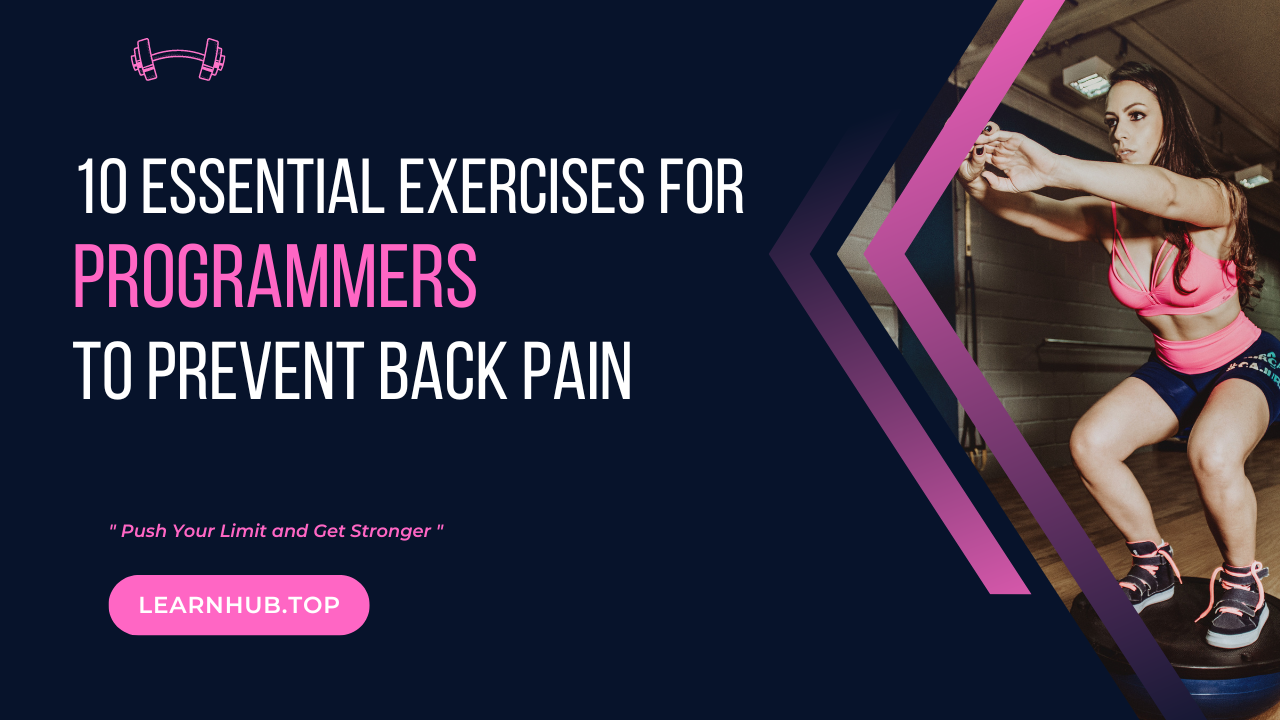Hey there, fellow coders! Let’s dive into a topic that’s as important as debugging that pesky piece of code you’ve been wrestling with: your health, specifically preventing back pain. We’re not just talking about the occasional stiffness; we’re tackling that deep, nagging ache that comes from marathon coding sessions. Here are ten life-saving exercises to keep your back as resilient as your code.
1. Desk Chair Swivels
- What: A simple, yet effective, twist to your routine.
- How: Sit upright, feet flat on the ground. Hold your desk and gently twist your torso left, then right. This gets the spine moving and grooving.
- Why: Keeps the spine flexible and breaks the monotony of being static.
- More Details: This movement gently engages your lower back and spinal joints. By sitting upright, feet flat, and using your desk to guide your twists, you ensure a controlled, beneficial twist to your routine.
- Benefits: Increases spinal mobility and can reduce stiffness throughout your workday. It’s a great way to keep the blood flowing without standing up, especially helpful during those long coding sessions.
2. Shoulder Blade Squeezes
- What: Great for counteracting the hunch.
- How: Sit/stand tall. Imagine holding a pencil between your shoulder blades and squeeze them together. Hold for 10 seconds, release, repeat.
- Why: Reduces shoulder and upper back tension.
- More Details: This exercise directly targets the muscles around your shoulder blades. By consciously squeezing these muscles, you’re working against the common forward slump many programmers develop.
- Benefits: Improves posture, reduces tension in the upper back and shoulders, and can also help alleviate neck pain by strengthening the muscles that support your upper spine.
3. The Programmer’s Stretch
- What: Specifically designed for those of us glued to our screens.
- How: Interlace your fingers, stretch them away from your body, then raise them overhead. Tilt slightly from side to side.
- Why: Stretches your arms, shoulders, and side muscles, promoting upper body circulation.
- More Details: This stretch is designed to target the areas most affected by prolonged sitting and keyboard usage. Extending your arms and tilting side to side enhances the stretch across your upper body, providing relief and improving flexibility.
- Benefits: Increases blood flow to your arms and shoulders, stretches out tight muscles around your chest and shoulders, and can help prevent the onset of repetitive strain injuries.
4. Standing Desk Dips
- What: Strengthens your arms and shoulders, and you don’t even have to leave your desk!
- How: Stand facing away from the desk, hands on the edge, and slowly lower your body, then push back up.
- Why: Engages the core and improves upper body strength, indirectly supporting your back.
- More Details: Utilizing your desk for dips helps engage your triceps, shoulders, and even your pecs. It’s an exercise that requires minimal movement but offers significant strength benefits.
- Benefits: Builds upper body strength which supports better posture. Strengthening these muscles means your spine has more support, potentially reducing back pain.
5. Leg Planks
- What: A sitting exercise that secretly works your core.
- How: Sit at the edge of your chair, legs together, straighten them out in front of you, and hold. Try for 30 seconds to start.
- Why: Strengthens your core muscles, which are crucial for good posture and back health.
- More Details: A seated version of a core plank, this exercise challenges you to maintain a straight leg position, activating your core muscles without the need for a gym.
- Benefits: Stronger core muscles lead to better posture, reduced lower back stress, and can improve your balance and stability, both in and out of your chair.
6. The Seated Figure Four
- What: Targets the hips and lower back.
- How: Sit, place one ankle on the opposite knee, lean forward slightly. You’ll feel a gentle stretch in your hip and lower back.
- Why: Loosens tight hips, which can contribute to lower back pain.
- More Details: This exercise stretches the piriformis muscle in the buttocks, a common source of sciatic pain, as well as the hips and lower back.
- Benefits: Reduces the risk of sciatic nerve pain, increases hip flexibility, and can alleviate lower back tension, making it easier to maintain a healthy posture.
7. Walkabouts
- What: The simplest yet most underrated exercise.
- How: Every hour, take a brisk 5-minute walk. Whether it’s around your home or office.
- Why: Boosts circulation and prevents the stiffness associated with prolonged sitting.
- More Details: Incorporating short, brisk walks into your routine breaks the cycle of prolonged sitting, getting your blood flowing and muscles moving.
- Benefits: Improves overall cardiovascular health, boosts energy levels, and can even enhance creativity and problem-solving by giving your brain a break from the screen.
8. Wall Angels
- What: Works wonders for your posture.
- How: Stand with your back against a wall, feet slightly forward. Slide your arms up and down as if making snow angels.
- Why: Improves shoulder mobility and corrects posture.
- More Details: This exercise mimics the movement of making snow angels against a wall, working against gravity to strengthen your back, shoulders, and arms.
- Benefits: Helps correct posture by realigning your spine and shoulders, increases shoulder mobility, and reduces upper back pain caused by slouching.
9. Cat-Cow Stretch
- What: A yoga classic for a flexible spine.
- How: Get on all fours. Arch your back up, tucking your chin (cat), then sag it down, lifting your head (cow).
- Why: Increases spine flexibility and relieves tension in the torso.
- More Details: A gentle, flowing movement that stretches the spine and helps to bring flexibility to the entire back.
- Benefits: Enhances spinal flexibility, encourages proper alignment, and can relieve tension in the lower back. It’s also a great stress reliever and helps with mental focus.
10. The Cobra Stretch
- What: An excellent way to end your routine.
- How: Lie on your stomach, palms next to your chest. Push your chest up, extending your spine, head up.
- Why: Stretches the front body and strengthens the spine.
- More Details: This yoga-inspired move strengthens the spine and opens up the chest and shoulders, counteracting the forward hunch.
- Benefits: Improves spinal strength and flexibility, reduces tightness in the lower back, and can help to alleviate posture-related discomfort. It’s also beneficial for improving breathing and reducing stress.
Remember, folks: Consistency is key. Incorporating these exercises into your daily routine can significantly reduce your risk of developing back pain. Plus, taking short breaks for physical activity can actually boost your productivity and creativity. So, give your back the same care and attention you give your code, and stay pain-free and productive!






